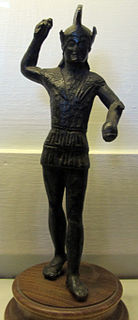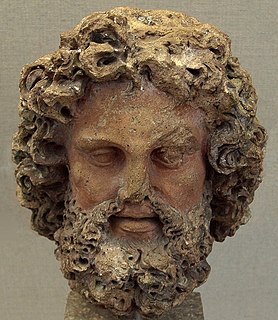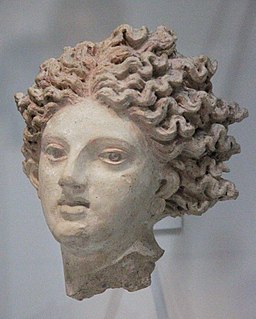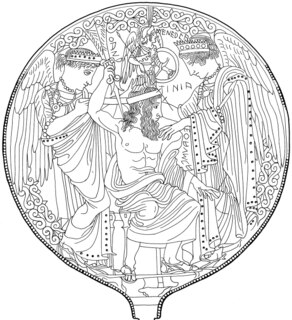Related Research Articles

Etruscan religion comprises a set of stories, beliefs, and religious practices of the Etruscan civilization, originating in the 7th century BC from the preceding Iron Age Villanovan culture, heavily influenced by the mythology of ancient Greece and Phoenicia, and sharing similarities with concurrent Roman mythology and religion. As the Etruscan civilization was assimilated into the Roman Republic in the 4th century BC, the Etruscan religion and mythology were partially incorporated into ancient Roman culture, following the Roman tendency to absorb some of the local gods and customs of conquered lands.

In Etruscan mythology, Charun acted as one of the psychopompoi of the underworld. He is often portrayed with Vanth, a winged figure also associated with the underworld.
In Etruscan religion, Fufluns or Puphluns was a god of plant life, happiness, wine, health, and growth in all things. He is mentioned twice among the gods listed in the inscriptions of the Liver of Piacenza, being listed among the 16 gods that rule the Etruscan astrological houses. He is the 9th of those 16 gods. He is the son of Semla and the god Tinia. He was worshipped at Populonia and is the namesake of that town.

In Etruscan mythology and religion, Laran is the god of war. In art, he was portrayed as a naked youth wearing a helmet, a cuirass and carrying a spear, shield, or lance. Laran also appears to be an underworld god. Among his attributes is his responsibility to maintain peace. According to some scholars, he also seems to have been the guardian of boundaries as shown by the boundary cippi found in Bettona with the inscriptions tular Larna and tular larns. Along with eight other Etruscan gods, he can wield lightning. Due to the Tabula Capuana we know that the Laran festival was celebrated on the Ides of May. Laran is the Etruscan equivalent of the Greek Ares and the Roman Mars. Like many other Etruscan gods, his name is gender neutral.

Menrva was an Etruscan goddess of war, art, wisdom, and medicine. She contributed much of her character to the Roman Minerva. She was the child of Uni and Tinia.
Nortia is the Latinized name of the Etruscan goddess Nurtia, whose sphere of influence was time, fate, destiny, and chance.
In Etruscan religion and myth, Thalna was a divine figure usually regarded as a goddess of childbirth. Determinate gender, however, is not necessarily a characteristic of Etruscan deities, and Thalna is also either depicted as male, or seems to be identified as a male figure because of the placement of names around a scene. Her other functions include friendship and prophecy. Her name may mean "growth, bloom." She appears in Etruscan art in the company of Turan, Tinia, and Menrva.

In Etruscan religion and mythology, Tinia was the god of the sky and the highest god in Etruscan mythology, equivalent to the Roman Jupiter and the Greek Zeus. However, a primary source from the Roman Varro states that Veltha, not Tins, was the supreme deity of the Etruscans. This has led some scholars to conclude that they were assimilated, but this is speculation. He was the husband of Uni and the father of Hercle. Like many other Etruscan deities, his name is gender neutral.

In Etruscan Religion and mythology, Thesan is the Etruscan goddess of the dawn, divination and childbirth and was associated with the generation of life. She was identified with the Roman Aurora and Greek Eos. However, she was also interpretio graeca with Leucothea and interpretio romana with Mater Matuta. In Etruria, she received offerings together with the sun god Usil in the liber linteus. She was especially worshipped at Caere and the city’s harbor Pyrgi, where a singular series of ‘‘daybreak antefixes’’ was excavated.

In Etruscan religion, Hercle, the son of Tinia and Uni, was a version of the Greek Heracles, depicted as a muscular figure often carrying a club and wearing a lionskin. He is a popular subject in Etruscan art, particularly bronze mirrors, which show him engaged in adventures not known from the Greek myths of Heracles or the Roman and later classical myths of Hercules.

Turan was the Etruscan goddess of love, fertility and vitality and patroness of the city of Velch.

Uni is the ancient goddess of marriage, fertility, family, and women in Etruscan religion and myth, and the patron goddess of Perugia. She is identified as the Etruscan equivalent of Juno in Roman mythology, and Hera in Greek mythology. As the supreme goddess of the Etruscan pantheon, she is part of the Etruscan trinity, an original precursor to the Capitoline Triad, made up of her husband Tinia, the god of the sky, and daughter Menrva, the goddess of wisdom.
Semla is the Etruscan equivalent for the Greek goddess Semele, daughter of the Boeotian hero Cadmus and mother of the Greek god of wine, Dionysus, by Zeus. Her name also is sometimes spelled Semia.

Usil is the Etruscan god of the sun. This name appears on the bronze liver of Piacenza, next to Tiur, the moon. Another iconic depiction features Usil rising out of the sea, with a fireball in either outstretched hand, on an engraved Etruscan bronze mirror in late Archaic style, formerly on the Roman antiquities market. On Etruscan mirrors in Classical style, Usil appears with a halo.

In Greek mythology, Gaia, also spelled Gaea, is the personification of the Earth and one of the Greek primordial deities. Gaia is the ancestral mother—sometimes parthenogenic—of all life. She is the mother of Uranus, from whose sexual union she bore the Titans, the Cyclopes, and the Giants; as well as of Pontus, from whose union she bore the primordial sea gods. Her equivalent in the Roman pantheon was Terra.

Catha is a female Etruscan lunar or solar deity, who may also be connected to childbirth, and has a connection to the underworld. Catha is also the goddess of the south sanctuary at Pyrgi, Italy She is often seen with the Etruscan god Śuri with whom she shares a cult. Catha is also frequently paired with the Etruscan god Fufluns, who is the counterpart to the Greek god Dionysus, and Pacha, the counterpart to the Roman god Bacchus. Additionally, at Pyrgi, Catha is linked with the god Aplu, the counterpart to the Greek god Apollo. Aplu may have even taken some of the characteristics of Catha when he was brought into the Etruscan religion. Giovanni Colonna has suggested that Catha is linked to the Greek Persephone since he links Catha's consort, Suri, to Dis Pater in Roman mythology.
Leinth is an Etruscan deity. Within Etruscan iconography, it is difficult to distinguish mortals from divine figures without inscriptions. Inscriptions to the god Leinth have only been identified on two bronze mirrors and a single fragment of ceramic, found within an artisan’s zone on an Etruscan site in Italy. It is difficult, with such little evidence, to determine what may seem to be even the most rudimentary qualities of the deity, because the Etruscans did not consistently assign specific genders or attributes to their gods. Leinth appears both as a male and a female on two different bronze mirrors, and aside from the inscription, there seem to be no distinguishing traits to connect the figures.

Ethausva is an Etruscan divine figure that appears in a few Etruscan inscriptions. She is depicted as a winged female richly robed and wearing a jeweled crown on her head. Her lack of mention on Etruscan artwork and inscriptions suggest that she was not very common, but she was considered canon to the Etruscan Pantheon so she was still known during the time of the Etruscans.

Culsans (Culśanś) is an Etruscan deity, known from two inscriptions and a variety of iconographical material which includes coins, statuettes, and a sarcophagus. Culśanś is usually rendered as a male deity with two faces and at least two statuettes depicting him have been found in close association with city gates. These characteristics suggest that he was a protector of gateways, who could zealously watch over the gate with not one, but two pairs of eyes.
References
- ↑ Nancy Thomson De Grummond, Etruscan Myth, Sacred History, and Legend (University of Pennsylvania Museum of Archaeology and Anthropology, 2006), p. 43, 106.
- ↑ De Grummond, Etruscan Myth, p. 105.
- ↑ De Grummond, Etruscan Myth, p. 105–106.
- ↑ Giuliano Bonfante and Larissa Bonfante, The Etruscan Language: An Introduction (New York University Press, 2002, revised edition), p. 166.